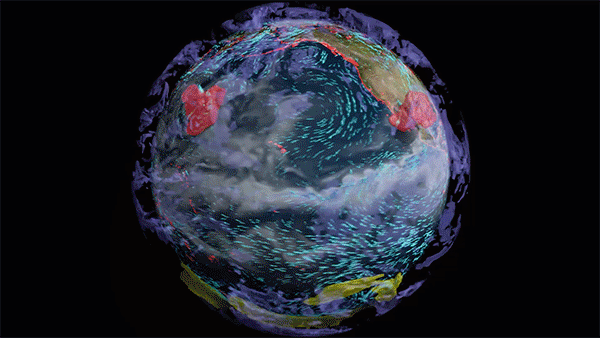
Physics-informed machine learning (physics-ML) is transforming high-performance computing (HPC) simulation workflows across disciplines, including computational…
Physics-informed machine learning (physics-ML) is transforming high-performance computing (HPC) simulation workflows across disciplines, including computational fluid dynamics, structural mechanics, and computational chemistry. Because of its broad applications, physics-ML is well suited for modeling physical systems and deploying digital twins across industries ranging from manufacturing to climate sciences.
NVIDIA Modulus is a state-of-the-art physics-ML platform that blends physics with deep learning training data to build high-fidelity, parameterized surrogate models with near-real-time latency. The surrogate models built using NVIDIA Modulus help a wide range of solutions including weather forecasting, reducing power plant greenhouse gasses, and accelerating clean energy transitions.
NVIDIA Modulus customer success stories are proving the platform’s incredible utility across industries. However, physics-ML is a relatively new field in the deep learning arena, with significant challenges both at the research level as well as at the application front. This is due to the unique requirements needed to satisfy physics-ML rules:
- The need for a deep learning model to obey the governing principles of a physical system.
- The need for new deep learning model architectures for a specific class of problems, such as those that can satisfy fluid mechanics laws.
- The need for generalizable model architectures and algorithms that can serve across different applications.
These challenges require innovation and research across several domains. More importantly, these problems require a strong collaboration between respective domains, industries, and deep learning experts. This level of collaboration requires tools and technologies that remove barriers between researchers, teams, and even industries, to enable the community to build on each other’s work.
Because simulations are critical to these disciplines and the industries that employ them, there is a demand for building and demonstrating confidence that AI can meet and surpass the current simulation approaches. This requires transparency so research can identify the limitations and provide breakthroughs to enable more transformative technologies.
Now, to facilitate the collaboration, transparency, and accountability needed, NVIDIA Modulus has become an open-source platform available for physics-ML.
Physics-ML open-source workflows
This new open-source environment provides significant benefits for AI developers and domain experts across industries in several ways:
- Collaboration: An open-source workflow enables you to collaborate more easily with colleagues and share your work with a wider community. By making data, code, and methods openly accessible, you can work together more effectively to address complex physics-ML questions.
- Transparency: Open-source workflows can increase the transparency and reproducibility of physics-ML research. By publishing code and data, you can enable other researchers to verify and replicate your results, which can help to build greater trust in the scientific findings.
- Innovation: Open-source workflows can facilitate innovation by enabling you to build on other researchers’ work more easily. By providing access to a shared repository of tools and techniques, open-source workflows can help to accelerate the pace of discovery and enhance the quality of research outputs.
- Accessibility: Open-source workflows can help to make research more accessible to a wider range of stakeholders, including drug development managers, national lab directors, policymakers, journalists, and members of the public. By providing clear, accessible information about physics-based modeling research, open-source workflows can help build greater awareness and understanding.
Overall, an open-source workflow can help AI developers and engineering and science domain experts to work more collaboratively, transparently, innovatively, and with greater accessibility to enhance the impact and relevance of their research.
Accessing NVIDIA Modulus open-source software
NVIDIA Modulus is available as open-source software (OSS) under the simple Apache 2.0 license.
Part of this update includes recipes for you to develop physics-ML models for reference applications. You are free to use, develop, and contribute, no matter your field. You have access to open-sourced repositories that suit different workflows, from native PyTorch developers to engineers that think in terms of symbolic partial differential equations.
Over the last couple of years, the NVIDIA Modulus team has worked with enterprise-scale customers and AI researchers to expand the platform’s capabilities. The platform now covers more domains, covers both data-driven and physics-driven approaches, and solves problems at an industrial scale.
As a result, NVIDIA Modulus also includes the data-driven neural operator family of architectures, including graph neural networks and physics-informed neural networks. For example, you can now design climate simulations on NVIDIA Modulus with FourCastNet, a physics-ML model that emulates the dynamics of global weather patterns with unprecedented speed and accuracy (Video 1).
Video 1. Accelerating Extreme Weather Prediction with FourCastNet
While the reference samples serve as a great starting point for engineers and developers, much work remains both in terms of fundamental research on generalizable models on one end to the application of these models to a gamut of real-world applications. This is only possible through a community-driven effort and serves this community in leveraging the full potential of such technologies.
Find the full Modulus source code in the NVIDIA/modulus repo on GitHub.
Register for free to attend GTC and discover how groundbreaking technologies are shaping the world. Add sessions focused on climate science and Earth-2 to your conference agenda.
Source:: NVIDIA